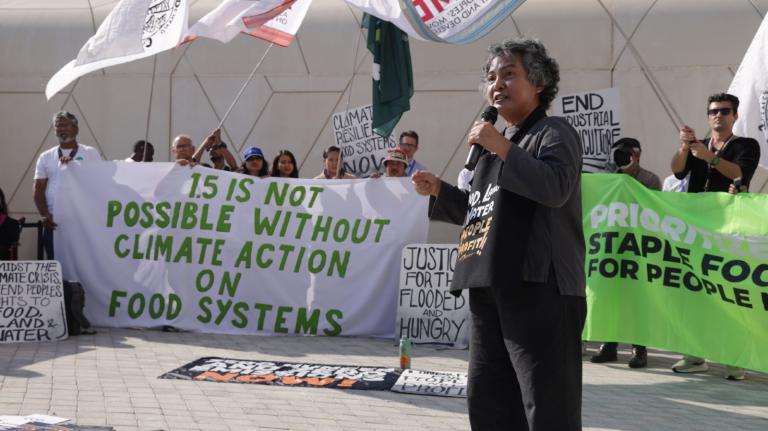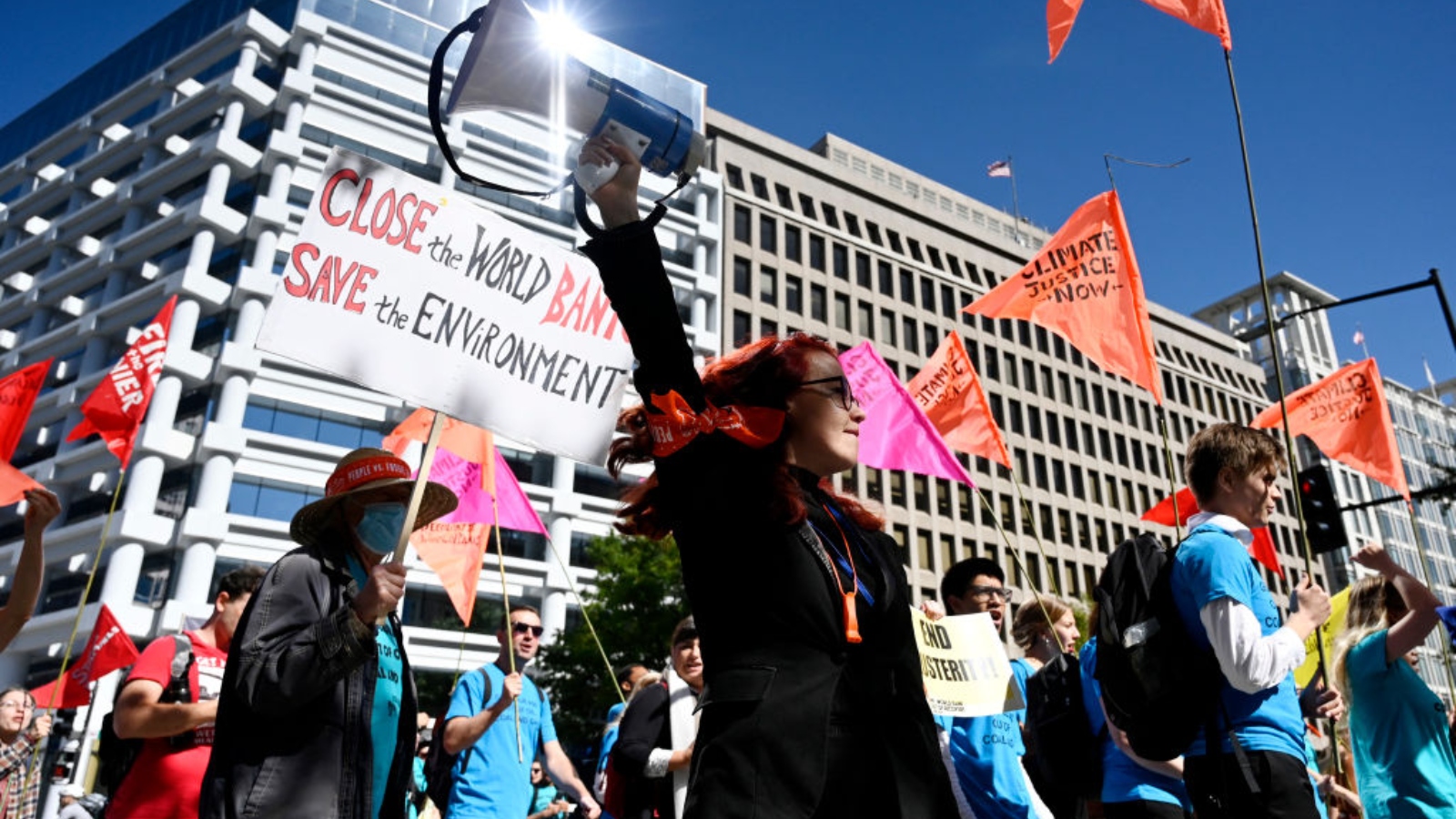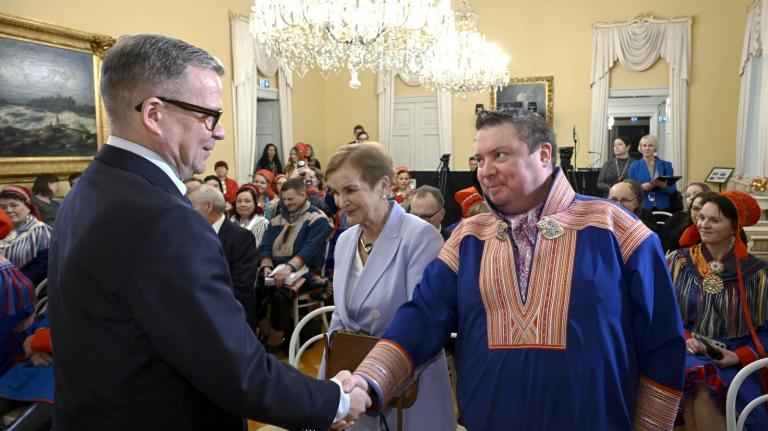Over the course of its 75-year history, the World Bank has been the go-to organization for solving global crises: It was charged with rebuilding Europe after the Second World War, and then again with reconstructing Iraq and Afghanistan after they were invaded by the U.S. During the global economic downturn of the 1970s, it loaned poor countries millions of dollars with the stated purpose of ending third world poverty. And earlier this month, the institution was picked to manage one of the most monumental tasks of the century: dispensing climate reparations to the developing world.
The World Bank’s role managing this so-called loss-and-damage fund was formalized on the very first day of COP28, this year’s United Nations climate conference, which just concluded in the United Arab Emirates. The fund, which provides a trove of money for relatively poor countries that have emitted little carbon yet disproportionately suffer the effects of climate change, was capitalized with more than $650 million in just a few days after the start of the conference.
But this success came after a string of furious debates, in which representatives from several coastal and low-income nations expressed vehement opposition to the World Bank’s management of the fund. When developing countries finally agreed that the Bank could host the fund on an interim basis for the next four years, they included a long list of conditions that the institution must meet. The deal was struck largely due to attrition, after weeks of negotiations in which wealthy nations, largely led by the U.S., rejected an alternative to set up a standalone fund.
Grist spoke with former World Bank employees, COP28 negotiators, and watchdog groups to understand the opposition to the World Bank’s role in the unprecedented effort to pay out climate reparations from the new loss-and-damage fund. Experts unanimously agreed that developing countries have little trust in the World Bank as a result of its governing structure, which gives the U.S. outsized influence, as well as the failures of its past programs, which led to debt crises that compounded poverty in many developing nations during the 1980s and 1990s. Moreover, the Bank’s track record as a major investor in fossil fuel projects around the world has led some critics to question its fitness for a position meant to battle climate change.
“The structure of the international organizations [like the World Bank] reflects a global power structure that is no longer the case, no longer true,” said Paul Cadario, a 37-year veteran of the World Bank who is now a distinguished fellow at the University of Toronto. “It doesn’t give sufficient weight to the concerns of the Global South. Those concerns are inevitably going to wash over something as specific as the loss-and-damage fund.”
The World Bank’s primary function is that of a credit institution — a bank like any other. Given its creditworthiness, the bank borrows money at low interest rates, which it then loans to developing nations. It is in part this setup that has sounded alarms among potential loss-and-damage fund recipients: Grantmaking and fund management, two integral components of the loss-and-damage effort, are not core functions of the bank. While the exact extent to which the loss-and-damage funding will take the form of no-strings-attached grants versus interest-bearing loans is unclear, developing nations have argued vehemently against loans that would further trap heavily indebted nations.
The World Bank has gained some relevant experience over the last few decades, as it’s taken responsibility for the management of a handful of funds designed to provide capital to developing countries trying to reduce carbon emissions and adapt to a warming world. As the trustee of these funds, the bank is responsible for fundraising and allocating the money raised. A loss-and-damage fund would likely work the same way: The bank would appeal to various donor countries for funds, which it would then pass on to developing nations for specific projects.
But the bank has historically been slow to deploy these funds. The Green Climate Fund was established by climate negotiators at COP16 in 2010 to help developing countries tackle the climate crisis. It’s the largest multilateral fund of its kind and has received about $33 billion in pledges so far. But countries in need have had difficulty accessing the money, because project approvals take several years. The Philippines, a low-lying archipelago threatened by sea-level rise and typhoons, had just one of seven projects it proposed over seven years approved in 2021.
“The process is extremely slow and very bureaucratic,” said Rohit Khanna, a former manager of global energy programs at the World Bank who also helped set up one of the bank’s climate funds. “The Green Climate Fund Secretariat is quite risk averse. The Secretariat is just anxious that if something goes wrong, the fund will die in its infancy.” (The Secretariat is a World Bank employee who manages the day-to-day operations of the fund.)
The highly bureaucratic process is a burden for developing countries, said Michai Robertson, a negotiator for small island states like Tuvalu, the Marshall Islands, and Barbados. The bank often had lengthy reporting requirements to guard against fraud and corruption, and at times it made well-meaning but impractical information requests, he added. In one case, the bank asked for 30 years of weather data in conflict zones where such data did not exist. Robertson attributed the logjams to “a lack of trust in developing countries and their systems.”
“It’s very colonial in its mindset,” he added.
In exchange for running the funds, the bank charges fees that are primarily used to pay its staff, many of whom live in expensive cities like Washington, D.C., and New York. In recent years, those costs have been increasing. The bank increased its fees from 12 percent to 17 percent, calculated as a percentage of the Secretariat’s operational costs for running the Global Partnership for Education fund a few years ago. More recently, it tried to increase those costs to 24 percent before they were negotiated down to about 20 percent.
“I don’t think the bank is transparent” about its fee structure, said Khanna. “The bank is not cheap, that’s for sure. The fees are high, and part of it is just the fact that you’re paying for a lot of stuff in Washington, D.C.” Khanna said costs in the low teens for the loss-and-damage fund would be acceptable, but anything as high as 24 percent would be “outrageous.”
The objection to the World Bank’s involvement in the loss-and-damage fund goes beyond its high fees and bureaucracy. Its critics charge more broadly that the institution has consistently pushed programs that have impoverished vast swaths of the developing world.
The World Bank and the International Monetary Fund were set up in the aftermath of the Second World War. At a two-week conference in Bretton Woods, New Hampshire, which was organized by the U.S. and British governments, leaders from 44 countries gathered to find ways to rebuild international currencies sunk by the war and “to promote worldwide reconstruction.” Initially, that meant promoting policies that favored substantial government intervention in the economy. In the decades after its founding, the World Bank encouraged countries in the Global South to take out millions of dollars in loans to dam rivers and erect power stations, assuring them that the new infrastructure would increase export revenue by enabling industrial production and pull their people out of poverty.
That plan did not pan out, according to University of Minnesota professor Michael Goldman, who has written one of the seminal books about the World Bank. While the bank pushed many developing countries to invest in industries that ultimately did not have longevity, rich nations’ hunger for many of the Global South’s key commodities began to dwindle. The commodities that had generated export revenue for developing countries were largely replaced by cheap synthetic alternatives: corn syrup instead of sugar, polyester instead of cotton, particle board instead of timber. As the market value of these commodities plummeted, poor nations’ foreign debt ballooned, reaching $1 trillion by 1986.
Rather than diminishing the World Bank’s stature, however, the global debt crisis placed the bank in the position of solving the colossal problem that it had a dominant hand in creating.
Governments in the developing world started borrowing large sums just to pay off the interest on their old loans. But these new loans came at a steep cost: The World Bank was stacked with people who believed that state-led development had failed and a free market approach would benefit indebted nations. As a result, the bank promised to bail out poor countries on the condition that they implement specific economic policies that, while on their face were intended to pull countries out of debt, ultimately served the interests of wealthy northern nations by allowing foreign companies to privatize public sectors.
These 1990s-era “structural adjustment programs,” as they were known, marked a radical departure from the World Bank’s founding ideology. Rather than push for government intervention in developing markets, the bank ordered borrowers to liberalize their economies by eliminating trade restrictions and allowing foreign companies to privatize previously public functions like electricity and mining. In the ensuing decade, people living in the borrowing countries struggled under policies that also saw the elimination of critical government subsidies and social welfare programs.
“It was considered ‘the lost decade’ because of the austerity programs the World Bank implemented to get back its money to repay its investors,” Goldman told Grist. In Mexico, for example, the government was forced to take out structural adjustment loans after racking up $80 billion in debt to U.S. banks by 1982. Provisions in the loans “completely revamped the Mexican state and economy, eliminating food subsidies, rural public agencies, national food security systems, and state-owned food monopolies,” Goldman wrote in his book, Imperial Nature.
The ideology behind structural adjustment — which promoted market liberalization, state austerity, and public sector privatization — permeated every arm of the World Bank during the 1980s, according to Robert Wade, a professor of political economy at the London School of Economics. When Wade started working at the institution in 1984, he had already lived in Taiwan and South Korea, where government intervention in the economy had improved the prospects of millions of people. At the bank, however, he found that no one was interested in these success stories. He departed four years later, “with the sense that the World Bank was ideologically driven in a direction that I thought was inappropriate for developing countries,” Wade told Grist.
Structural adjustment is now widely considered a resounding failure among economists and development analysts. Since the turn of the millennium, the World Bank has shifted in new directions, focusing more on promoting good governance and “sustainable development.” But Wade told Grist that, at its core, the institution is still dominated by the perspectives and interests of rich countries. He pointed to the World Bank’s power structure: It is headquartered in Washington, D.C., its president is typically an American citizen handpicked by the U.S. president, and the U.S. is the only country to have a de facto right of veto at the bank. To this day, the U.S. remains the bank’s largest shareholder, providing more capital to the bank than any other country.
According to Jason Hickel, a professor at the Institute for Environmental Science and Technology in Barcelona, the average individual in the global South has one-eighth of the voting power in the World Bank as their counterpart in the global North. As a result, the bank’s hosting of the loss-and-damage fund would mean that the countries that have contributed the most to climate change would have the most power to administer the reparations for the harm they have caused.
“They’re playing a double game,” Wade said. “Western nations have a collective interest in pretending that they’re committed to giving money to this fund” while structuring it in a way that minimizes what they actually have to pay. That became clear at COP28 earlier this week, when delegates agreed to adopt a loss-and-damage fund that will start at $429 million — a small fraction of what developing countries say they will need to make up for the economic impacts of climate change. The U.S. in particular came under fire for offering up a paltry $17.5 million. (The United Arab Emirates and Germany, by comparison, each pledged $100 million). The cost of Pakistan’s devastating floods during the summer of 2022 were estimated to be around $40 billion alone.
To protect the loss-and-damage fund from the idiosyncrasies of the World Bank, developing nation negotiators set out some conditions that the bank has to meet. They include autonomy for the board that would oversee the fund, access to the fund for all developing countries, and fees that are “reasonable and appropriate.”
“What we agreed to was that rather than trying to shove ourselves into existing World Bank structures, we would establish a set of conditions that the World Bank must meet if it is to be the interim host,” said Avinash Persaud, special climate envoy and negotiator for Barbados. “If the World Bank doesn’t do a good job — and I’m not saying it won’t — then sacking the World Bank” is a possibility, he added.




